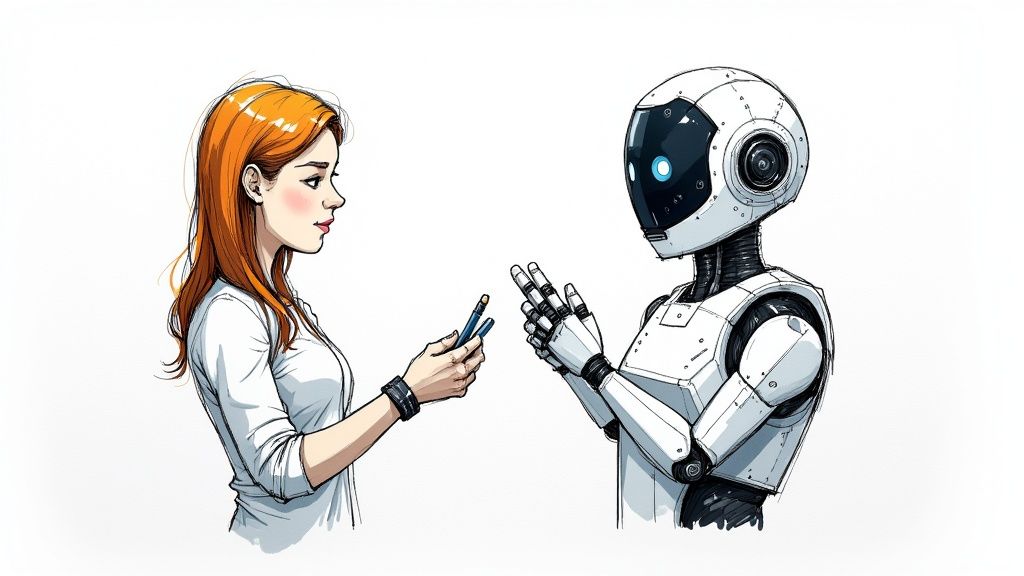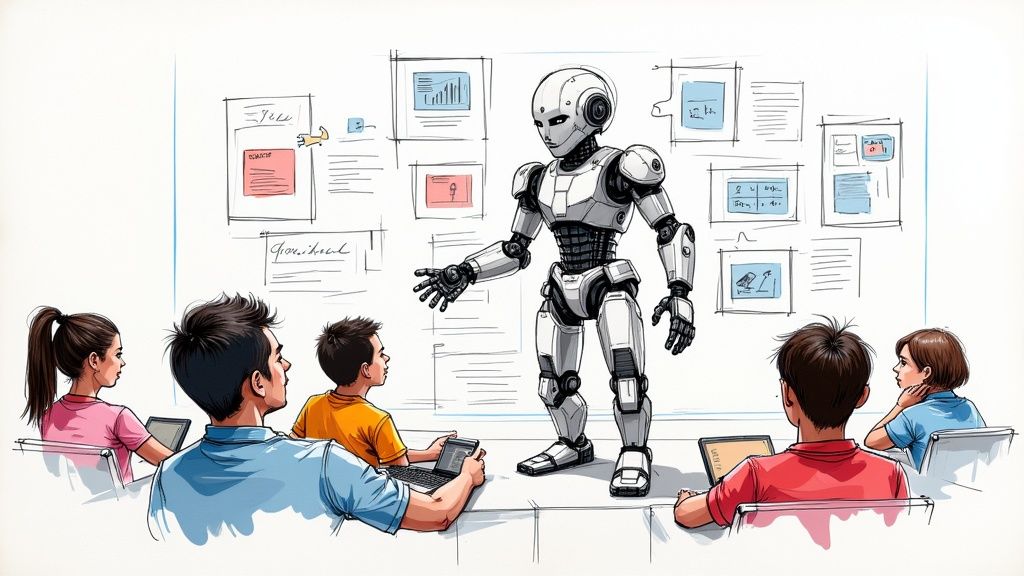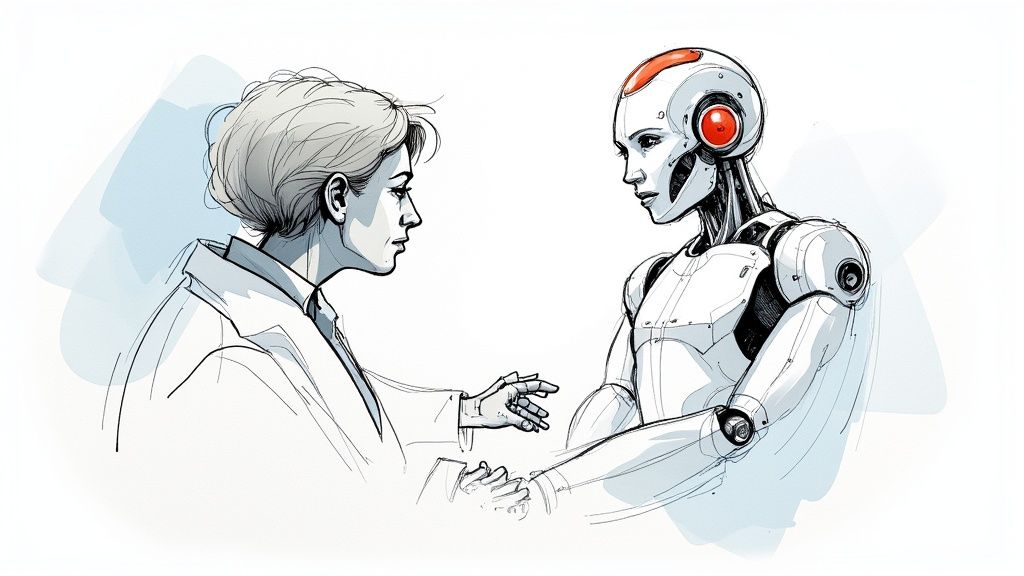AI Chatbot Examples: Industry Leaders Transforming Business
The Journey From Basic Chatbots to AI-Powered Solutions

When chatbots first emerged in the 1960s, they were remarkably simple. Take ELIZA, developed in 1966, which relied on basic decision trees and pre-programmed scripts. These early chatbots could only match keywords and provide canned responses, making their conversational abilities quite limited. They were a far cry from the sophisticated AI assistants we interact with today.
To understand their limitations, imagine trying to have a conversation with a chatbot that could only ask "What is your favorite color?" and respond with the same generic message no matter what you answered. These early systems couldn't grasp context or learn from interactions, restricting them to very specific, simple tasks. Still, these basic chatbots laid the essential groundwork for today's advanced AI conversations.
The Rise of Machine Learning
The introduction of machine learning brought a fundamental change to how chatbots work. Rather than following rigid rules, ML-powered chatbots could analyze data to spot patterns and better understand user intent. This meant they could handle more natural conversations and adapt their responses based on context. As these systems processed more interactions, they got better at providing relevant and helpful responses.
Natural Language Processing and Understanding
The next major step forward came with advances in Natural Language Processing (NLP) and Natural Language Understanding (NLU). These technologies gave chatbots the ability to grasp the subtleties of human communication - from casual conversation to specific requests. For example, a modern chatbot can tell the difference between someone ready to book a flight to London versus someone just dreaming about a future trip, and respond accordingly. This deeper understanding of language nuances has made chatbot interactions feel much more natural and helpful.
The Impact of Deep Learning
Deep learning has pushed chatbot capabilities even further. Modern deep learning models, especially transformer networks, can process massive amounts of text data to understand complex language patterns and generate remarkably human-like responses. You can see this in action with tools like ChatGPT, which maintains context across long conversations, creates original content, and even translates between languages smoothly. These advances have made AI-powered chat increasingly hard to distinguish from human conversation. The rapid progress is reflected in market growth too - experts predict the global AI chatbot market will reach $46.641 billion by 2029. As the technology continues to improve, we're likely to see even more practical applications emerge for businesses and everyday users alike.
Customer Service Transformation Through AI Chatbots

AI chatbots have come a long way from their simple beginnings as basic Q&A systems. Today's AI-powered chatbots are changing how companies connect with and support their customers, going far beyond just automated responses. Real-world examples show these tools are becoming essential for delivering quick, personal, and cost-effective customer service.
Enhancing Customer Experience with AI
The biggest advantage of AI chatbots is that they're always available to help customers. While human agents need to sleep and take breaks, chatbots can provide instant support 24 hours a day, 7 days a week. This is especially valuable for companies serving customers across different time zones. For example, if someone needs help at 3 AM, they don't have to wait until morning - the chatbot can help them right away. Quick response times like this make customers happier and more satisfied with the service they receive.
Streamlining Operations and Reducing Costs
AI chatbots handle many routine customer service tasks automatically. They can answer common questions, provide shipping updates, and walk customers through basic troubleshooting. This frees up human agents to focus on more complex issues that need a personal touch and careful thinking. By taking care of simple requests, chatbots help customer service teams work more efficiently. Companies see real savings too - according to IBM, businesses can cut customer service costs by up to 30% after adding chatbots.
Personalization and Intelligent Routing
Modern AI chatbots do more than just give standard answers. They learn from past conversations and customer data to provide personalized responses that fit each customer's specific needs. This personal touch helps build stronger connections between customers and brands. The chatbots are also smart about when to bring in human help. They can detect when a question is too complex or when a customer is frustrated, and smoothly transfer the conversation to the right human agent with the skills to help.
Measuring Chatbot Effectiveness and Seamless Integration
Success with AI chatbots requires good planning and execution. Companies need clear ways to measure how well their chatbots are performing, like tracking customer satisfaction scores, how many issues get resolved, and which problems need human help. This data shows what's working and what needs improvement. It's also important that chatbots work smoothly with existing customer service systems and staff. For more details on building this kind of integrated system, check out: Revolutionizing Customer Service: Creating Your Own GPT Chatbot. When chatbots and human agents work together effectively, they create a complete customer service system that combines the speed of AI with the understanding of human support.
E-commerce Innovation: Converting Browsers to Buyers

AI chatbots are quickly becoming an essential part of successful online shopping experiences. These virtual assistants do far more than just handle basic customer service - they actively guide shoppers through personalized buying journeys while boosting sales. By analyzing customer behavior and providing relevant recommendations, chatbots help convert casual browsers into confident buyers. For example, when a shopper is viewing products, the chatbot can suggest complementary items based on their interests, making the experience feel more like shopping with a knowledgeable friend.
Personalized Product Recommendations and Enhanced Customer Engagement
At the heart of effective e-commerce chatbots are smart recommendation engines that learn from each customer interaction. By examining browsing patterns, past purchases, and real-time conversations, these systems suggest products that truly match individual preferences. Instead of overwhelming shoppers with random options, chatbots present carefully chosen items they're most likely to want. A chatbot might notice someone browsing winter coats and proactively offer matching accessories or share styling tips. This personal touch helps create engaging conversations that naturally lead to sales.
Addressing Customer Queries and Streamlining the Sales Process
Modern chatbots excel at handling common customer questions about shipping, returns, and product details quickly and accurately. This frees up human staff to focus on more complex support needs while ensuring shoppers get fast answers. The result is a smoother path to purchase with fewer obstacles. For instance, if someone has questions about product sizing, the chatbot can immediately provide detailed measurements and fit guidance. During busy shopping periods like holidays, chatbots can simultaneously assist many customers without long wait times, keeping the sales process moving efficiently.
Building Trust and Overcoming Resistance to Automation
While chatbots offer clear benefits, some shoppers still prefer human interaction. Smart businesses address this by combining automated and human support. The chatbot handles initial questions but smoothly transfers complex issues to staff members when needed. Being transparent about when customers are talking to a bot versus a person helps set proper expectations. This balanced approach ensures shoppers feel supported while still benefiting from quick automated assistance. Learn more in our article about How to master chatbot integration for explosive sales growth.
The Future of AI Chatbots in E-commerce
The potential for chatbots in online retail continues to grow. As the technology advances, we'll see chatbots that can pick up on subtle shopping preferences, deliver perfectly timed promotions, and even predict customer needs before they arise. These improvements will create increasingly natural shopping experiences that blend the convenience of online browsing with the personal attention of in-store service. The key will be maintaining the human element while letting automation handle routine tasks more efficiently.
Secure Solutions for Regulated Industries

AI chatbots offer powerful capabilities for sectors like healthcare and finance, but implementing them requires careful consideration of strict regulatory requirements. Organizations in these fields must balance the benefits of automation with robust security measures to protect sensitive data. For healthcare providers, this means safeguarding confidential patient information, while financial institutions need to secure transactions and customer data. Getting this balance right demands specific technical approaches and security protocols.
Data Protection and Privacy in AI Chatbot Implementations
Strong encryption forms the foundation of secure chatbot deployment. Any data exchanged between users and the system must be encrypted, along with information stored in databases. Access controls add another essential layer of protection by restricting data to authorized personnel only. A healthcare chatbot, for example, would use multi-factor authentication and role-based permissions to limit patient record access to specific medical staff members. These security measures help build confidence among users who entrust sensitive information to these systems.
Maintaining Compliance with Industry Regulations
Healthcare and financial organizations must follow strict standards like HIPAA for medical data and PCI DSS for payment processing. Chatbots in these sectors need built-in features to meet compliance requirements from day one. This includes capabilities like data masking to hide sensitive details like credit card and social security numbers while still enabling core functionality. Regular security audits help identify potential weaknesses and ensure ongoing compliance. These measures protect both sensitive information and public trust in these essential services.
Balancing User Experience with Security Requirements
While strong security is non-negotiable, chatbots must remain easy to use to drive adoption. Smart implementation of security features can minimize friction in the user experience. For instance, biometric authentication or risk-based verification can streamline access while maintaining protection. AI-powered monitoring can spot suspicious patterns without disrupting normal interactions. This approach allows organizations to enhance security while keeping their chatbots accessible and useful for their intended audience.
Real-World Examples of Secure Chatbot Implementations
Many organizations have successfully deployed secure AI chatbots that demonstrate effective security practices. Healthcare providers use chatbots to schedule appointments, send medication reminders, and answer patient questions - all while maintaining HIPAA compliance. Financial institutions employ chatbots for account support, fraud detection, and financial guidance within PCI DSS guidelines. These examples show how organizations can use AI to improve services and efficiency while upholding security and regulatory requirements. The key is implementing appropriate safeguards without sacrificing usability.
Enterprise-Scale Implementation Success Stories
Moving beyond isolated implementations, organizations are now mastering large-scale AI chatbot deployments across their operations. This shift requires careful planning to integrate chatbots effectively across departments while showing clear business value. Companies are adopting comprehensive approaches that connect different teams and systems under a unified strategy.
Overcoming Integration Challenges at Scale
Large organizations face unique hurdles when connecting AI chatbots to their existing systems. Consider a global company running multiple CRM platforms and legacy software across regions - each with its own data formats. Making chatbots work smoothly in this environment means building strong connections through APIs so information flows properly between systems. For example, when a chatbot needs to check inventory levels for a customer, it must seamlessly pull real-time data from warehouse management systems. Protecting sensitive data across these connected systems is also essential.
Measuring Success and Demonstrating ROI
For company-wide chatbot programs to succeed, they need to show measurable benefits tied to business goals. Simple metrics like chat volume aren't enough - organizations track specific improvements in areas that matter. This includes reduced support costs when chatbots handle routine questions, higher sales conversion rates from 24/7 availability, better customer satisfaction scores, and productivity gains as staff focus on complex issues. These concrete improvements help justify continued investment in chatbot technology.
Combining Cloud Solutions With Existing Infrastructure
Companies often use cloud-based chatbots for their easy scaling, but connecting them to on-site systems takes careful planning. Many adopt a mixed approach - using cloud services for the chatbot while keeping sensitive data secure internally. This setup helps organizations add AI capabilities without disrupting their current IT environment. A bank might use cloud-based natural language processing while storing customer financial data on internal servers. This approach maintains both strong security and smooth functionality.
Managing Large-Scale Chatbot Deployments
Keeping chatbots running well across a big organization is like managing a large team - it needs clear structure and oversight. This means defining who's responsible for what, setting up monitoring systems, and creating processes for updates and improvements. Regular check-ins help ensure chatbots stay aligned with changing business needs. A strong management framework helps these automated systems deliver consistent value across departments. Read also: How to master chat bot support. With proper governance and maintenance procedures in place, enterprise chatbot programs can drive lasting benefits.
Next-Generation Chatbot Innovations
Today's chatbots are getting much better at understanding and interacting with users in natural ways. This progress comes from major improvements in natural language processing (NLP) and machine learning (ML), which help chatbots better grasp what users need and respond more effectively. These advancements are changing how businesses connect with customers and handle internal tasks.
Advancing Beyond Simple Conversations With Contextual Awareness
Modern chatbots can now follow conversations more like humans do. Unlike older versions that handled each message separately, new chatbots keep track of the entire conversation flow. When a customer asks about flights to London and then about hotels, the chatbot remembers they're interested in London and suggests hotels there automatically. This ability to maintain context throughout a conversation makes interactions feel much more natural and useful.
Personalization Through User Profiling and Behavioral Analysis
Today's chatbots get smarter about each user over time. By looking at past chats, what people buy, and how they browse, these chatbots can shape their responses to match individual preferences. For example, a chatbot might notice which clothing brands you like and let you know when those brands have new items or sales. As chatbots learn more about each user, they can spot patterns and offer help before it's even asked for, making the whole experience smoother.
Multimodal Interactions: Combining Text, Voice, and Visuals
Chatbots now work with more than just text - they can handle voice commands and process images too. This means users can talk to chatbots, show them pictures, or send messages, whatever works best at the moment. Picture someone showing a chatbot their broken appliance and getting instant repair tips or replacement part information. This mix of different ways to communicate makes chatbots much more practical and engaging to use.
Enhanced Integration With Business Systems and Workflows
Modern chatbots work seamlessly with other business tools. They can tap directly into customer databases, inventory systems, and other important company resources. This means a chatbot can do things like book appointments, process orders, or update customer files without needing human help. By connecting smoothly with existing business systems, chatbots help companies serve customers better and work more efficiently.
Ready to see how AI chatbots can help your business grow? Check out Sitebot to create custom chatbots that match your company's specific needs and brand style.


